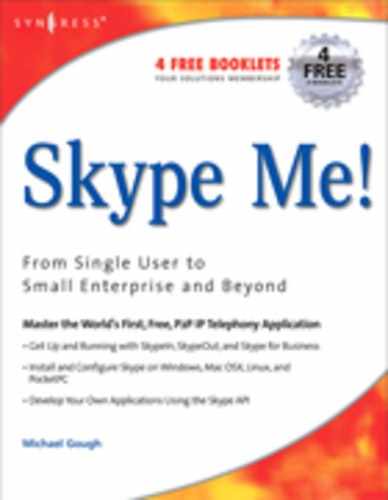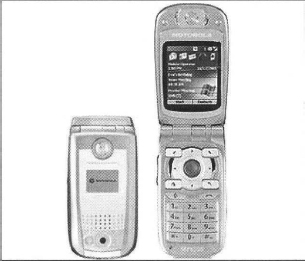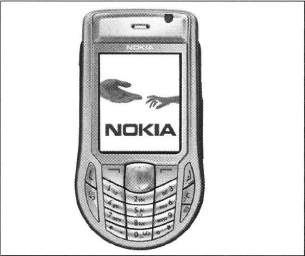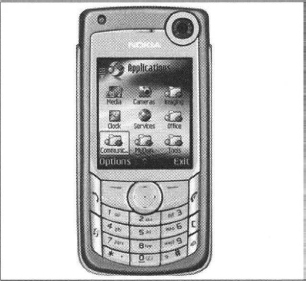Chapter 10 Being Mobile with Skype
Solutions in this chapter:
Using Skype with Your Laptop
The most obvious mobile use for Skype is while using your laptop. Many of us have laptops issued to us for work or have our own personal laptops so we can surf the Net while we sit on our porches looking at the trees and sipping a latte.
We discussed in a previous chapter why you would want to set up two accounts, and in Chapter 9 we discussed how to use Skype without sitting at your computer. So you can either use the same primary Skype account for both your laptop and your home computer, or you can use a different account for your laptop. One of the reasons you would want to use multiple accounts is so that people will know where you are and where to leave you a message or contact you. Think of Skype as being just like a cell phone and your home telephone—one of them is for your home and one of them allows you to be mobile.
As I discussed in Chapter 9, if you Skype me at home and I don’t answer, you will get my home answering machine. Then if you still wanted to reach me and I was online, you would call my other Skype account. Since Skype automatically changes the status to Away and Not Available, you would know when I am not at home, and when you saw my video, calls Skype contact come online, you would know I am on my laptop and mobile.
One good use of a USB phone, as we discussed in Chapter 8, is to carry it with your laptop to use just as a regular phone. USB phones are inexpensive and compact enough that they will fit nicely in your laptop bag and be available to you when you receive a Skype call. If you want to try it, give me a call when you see me online with video, calls and I can talk with you on my laptop with and without my USB phone.
Understanding the Basics … Use a Headset
Since laptops tend to have mediocre microphones and speakers, be sure to purchase a small headset or USB phone to use with your laptop to improve your Skype call quality.
Available USB Ports
Most laptops have two USB ports. This can pose a problem for those of us who use a small USB mouse and perform video calls using a Webcam that also connects via the USB interface. So if you are going to start using and exploiting Skype, we suggest you get a small USB hub to expand your available USB ports. For example, I have the following items connected to my laptop when I am traveling on the road:
As you can see, the number of gadgets far exceeds a laptop’s available USB ports. I travel with a tiny USB hub that gives me four additional ports, for a total of five ports on my laptop, so I don’t have to unplug one device to plug in another.
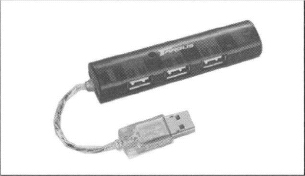
Photo as featured on www.Targus.com
In addition, we suggest you get a couple of USB extension cables to make connections even easier. Some USB devices are too wide to allow another device to plug in next to them, or the USB port is recessed and too short. You will need “Male A to Female A” cables to solve this problem.
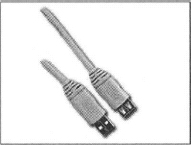
Photo as featured on www.belkin.com
Understanding the Basics … USB Cables
Get a couple of short USB dongles or extension cables to make it easier to connect multiple devices to a laptop or USB hub.
Using Skype with Pocket PCs
Lots of people have Pocket PCs that have built-in wireless cards or are combination Pocket PCs/cell phones with built-in WiFi, like the Samsung i730, the Siemens SX66, or the iMate KJam. Any Pocket PC with a 400MHz or faster processor and built-in or add-on wireless can also perform Skype calls. Feel free to give us a call on your Pocket PC device for a quality and sound test and we will add your device to the list we maintain on our Web site.
Pocket PC Cell Phones
Pocket PCs are for people who want Outlook functionality with them at all times, for calendar, contacts, Solitaire, and even e-mail. These devices are also designed for cell phone users who also want Microsoft Windows Mobile functionality. These devices sync well with Microsoft Office and Outlook, and you can listen to music, store files, and of course, make Skype calls over wireless. The list of devices discussed in this section is not complete by any means, but we did get e-mails on or various forums reported on all these units working with Skype. These devices can work with Skype using either built-in WiFi or the cell provider’s high-speed cellular network Internet offering.
NOTE
There is an additional cost to use a cell provider’s high-speed Internet access. Check the provider’s plan and costs to see if it is cost-effective for you. WiFi, on the other hand, is inexpensive or often free and works very well with Skype. Also, if you are going to use one of these devices, I recommend you keep a stock of multiple batteries, since power consumption will be an issue.
The i730 is probably the leader in the Pocket PC phone space. This device gets rave reviews, and the only drawback I know of is that WiFi does not operate when in cell mode. You must manually switch between Cell and WiFi modes. This is probably due to battery use, since having both running would drain the battery faster. Learn more at www.phonescoop.com/phones/phone.php?p=667.
Features
- Modes: CDMA 850/CDMA 1900
- OS: Windows Mobile for Pocket PCs version: 2003 Second Edition
- Processor: 520MHz Intel Bulverde processor
- Memory: 64MB RAM plus SDIO expansion slot for added memory
- Display: Type: LCD (color TFT/TFD), colors: 65,536 (16-bit), size: 240 x 320 pixels
- Bluetooth: Version 1.1/primary supported profiles: headset, hands free, OBEX
- Headset: 2.5mm
- WiFi: Yes, 802.11b
- Keyboard: Slide-out QWERTY
- Speakerphone
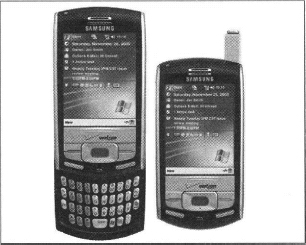
Photos as featured on www.phonescoop.com
The Siemens SX66 seems to generate either a love or a hate scenario. Many reviews claim early versions of this device are flawed and lock up frequently. I have two friends who use this phone with Cingular and love it, though they do complain about battery consumption. Learn more at www.phonescoop.com/phones/phone.php?p=569.
Features
- Modes: GSM 850/GSM 900/GSM 1800/GSM 1900
- OS: Windows Mobile for Pocket PCs version: 2003 Second Edition up to 96MB Flash memory
- Processor: 400MHz xScale processor
- Memory: 96MB (built-in, Flash shared memory) plus 128MB SDRAM
- Display: Type: LCD (color TFT/TFD), colors: 65,536 (16-bit), size: 240 x 320 pixels transflective TFT; supports landscape mode
- Bluetooth: Version 1.1/class 2
- Headset: 2.5mm
- WiFi: Yes
- Keyboard: Slide-out QWERTY
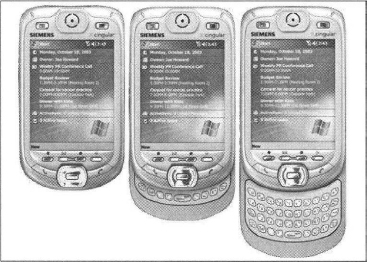
Photos as seen on www.phonescoop.com
iMate is the leader in Skype integration for Pocket PC phones, and several of the iMate phones are used by many cellular providers. The Siemens SX66 shown in the previous section is the iMate PDA2K. If you have access to a provider for these devices, take a serious look. You can learn more at www.image.com/DETAILS_KJAM.htm.
Features
- Modes: 850/900/1800/1900MHz, GSM/GPRS/EDGE
- OS: Windows Mobile 5.0 Pocket PC Phone Edition
- Processor: TI OMAP 850, 200MHz
- Memory: 128MB ROM/64MB RAM
- Display: Type: LCD (color TFT/TFD), colors: 65,536 (16-bit), size: 240 x 320 pixels transflective TFT; supports landscape mode
- Bluetooth: Version 1.1/class 2
- Headset: 2.5mm
- WiFi:Yes, 802.11b,g,e
- Keyboard: Slide-out QWERTY
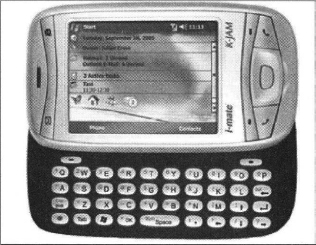
Photo as featured on www.imate.com
The Sprint PPC-6700 Pocket PC phone gets very high user ratings for ease of use. As with the iMate, the slide-out keyboard is very popular with reviewers. Learn more at www.spring.com/business/products/phones/ppc6700_allPcsPhones.jsp.
Features
- Modes: CDMA (800/1900MHz) and 1x-EVDO
- OS: Windows Mobile 5.0 Pocket PC Phone Edition Software
- Processor: Intel PXA 270 416MHz Processor
- Memory: 64MB RAM; 128MB Flash ROM
- Display: 240 x 320 Pixel TFT Touch Screen supporting over 65K colors
- Bluetooth: Version 1.2
- Headset: 2.5mm
- WiFi: Yes
- Keyboard: Slide-out QWERTY
- Speakerphone
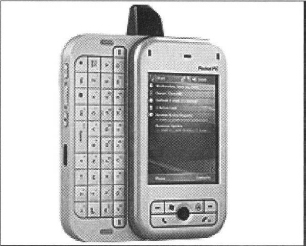
Photo as featured on www.sprint.com
HP’s latest Pocket PC Phone looks and feels like a RIM Blackberry device with Pocket PC functionality. This device is smaller than a standard Pocket PC device. Learn more at www.bargainpda.com/default.asp?newsID=2624.
Features
- Modes: Quad band 850/900/1800/1900MHz with GSM/GPRS and EDGE
- OS: Windows Mobile 5.0, Phone Edition
- Processor: Intel PXA270 312MHz CPU
- Memory: 128MB Flash ROM
- Display: 3-inch TFT 240 x 240 pixel display
- Bluetooth: Yes
- WiFi: 802.11g
- Keyboard: QWERTY
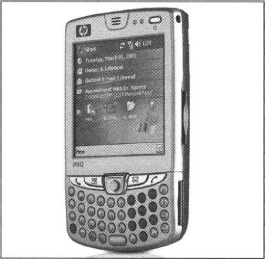
Photo as featured on www.bargainpda.com
Using Skype with Smartphones
Smartphones are more cell phone than Pocket PC; they do have Windows Mobile software but not all the features of a Pocket PC. If you are looking for a smaller device than a Pocket PC, a smartphone might be for you. In this section we list a few of the more popular models that are reported to work with Skype. These devices use the cell provider’s high-speed cellular network Internet offering to connect with Skype, since smartphones do not have integrated WiFi and a Pocket PC phone can have WiFi. Skype works using the cellular provider’s high-speed network. You will have to sign up for the provider’s Internet service offering at an additional cost; Internet access plans will vary by provider.
NOTE
There is an additional cost to use a cell provider’s high-speed Internet access. Check the provider’s plan and costs to see if this is cost effective for you.
Audio Vox SMT5600 (Orange SPV C500)
The AudioVox SMT5600 phone is used by Orange and other cellular providers. This phone does not have WiFi but does have a speakerphone, which is key in my opinion. Learn more at www.audiovox.com/webapp/wcs/stores/servlet/ProductDisplay?catalogId=10001&storeId=10001&productId=13758&langld=-1.
Features
- Modes: Tri Band GSM 850/1800/1900MHz GPRS Class 10
- OS: Microsoft Windows Mobile 2003 Second Edition software for Smartphone
- Processor: TI OMAP 730 ARM family 200MHz
- Memory: 32 MB RAM
- Display: 2.2 inch, 176 x 220 pixels TFT LCD with 64K colors
- Bluetooth: Yes
- Headset: 2.5mm
- WiFi: No
- Speakerphone
Photo as featured on www.infosyncworld.com
Samsung i600
The Samsung i600 is an older-style flip phone that is compact and Skype capable. Find out more at http://product.samsung.com/cgibin/nabc/product/b2c_product_detail.jsp?prod_id=SP-i600.
Features
- OS: Microsoft Windows Mobile 2003 Software
- Processor: PXA250 200MHz
- Memory: 32 MB RAM, 32MB ROM
- Display: 2.2 inch, 176 x 220 pixels TFT LCD with 64K colors
- Bluetooth: No
- Headset: 2.5mm
- WiFi: No
- Speakerphone
Photo as featured on http://product.samsung.com
Motorola MPX220
Motorola has announced that it will be integrating WiFi into its phones, and the company makes a good-quality phone. I believe Motorola will have Skype-enabled phones in the near future. Learn more at www.motorola.com/motoinfo/product/details/0,,53,00.html.
Features
- Modes: Quad Band Performance (850/900/1800/1900)
- OS: Windows Mobile for Smartphones 2003 version
- Processor: TI OMAP 1611 200MHz
- Memory: 64MB ROM
- Display: Type: LCD (color TFT/TFD), colors: 262,144 (18-bit), size: 176 x 220 pixels TFT/65,000 colors for wallpaper
- Bluetooth: Yes
- Headset: 2.5mm
- WiFi: No
- Speakerphone
Photos as featured on www.motorola.com
Nokia 6630
Nokia makes some of the first true cellular-based video phones that are capable of two-way video phone calls. Nokia makes good phones with a variety of functions. Many have been tested to work with Skype. Learn more at www.europe.nokia.com/nokia/0,,1072,00.html.
Features
- Modes: UMTS/GSM 900/GSM 1800/GSM 1900
- OS: Symbian OS 8.0a, Series 60 UI
- Memory: 64MB card included, hot swap 10MB shared memory for storage
- Display: TFT, 256K colors, size: 176 x 208 pixels
- Bluetooth: Yes
- Headset: 2.5mm
- WiFi: No
- Speakerphone
Photo as featured on www.europe.nokia.com
Nokia 6680
Nokia makes some of the first true cellular-based video phones that are capable of two-way video phone calls. The 6680 has a built-in camera for video calls. Learn more at www.europe.nokia.com/nokia/0,,1072,00.html.
Features
- Modes: UMTS/GSM 900/GSM 1800/GSM 1900
- OS: Symbian OS 8.0a, Series 60 UI
- Memory: 64MB card included, hot swap 10MB shared memory for storage
- Display: TFT, 256K colors, size 176 x 208 pixels
- Bluetooth: Yes
- Headset: 2.5mm
- WiFi: No
- Speakerphone
Photo as featured on www.europe.nokia.com
Using Skype with Wireless Pocket PCs
These devices do not have cell phone capabilities. With typical WiFi 802.11b and 802.11g, you can connect with any computer, laptop, or Pocket PC that can run Skype. We don’t recommend 802.11a, since it does not run on a Pocket PC, but if you have it on your laptop, 802.11a will work fine as long as you can connect. Most public hotspots are 802.11b or 802.11g. Skype will work well in any WiFi location with a signal strength of 50 percent or stronger. Your local Starbucks, WiFi hotspot, airport, home, and business that has wireless running will work well for Skype.
We are asked all the time what devices work well with Skype on a Pocket PC. The minimum requirements are:
- Windows Mobile 2003 for Pocket PC
- 400MHz processor
- WiFi-enabled
You can read the article we did last year in testing Pocket PC units with Skype at www.skypetips.internetvisitation.org/articles/pocketPC.html.
The following is a list of older Pocket PCs about which we had feedback that they worked with Skype. It is not a complete list; new units are coming out all the time, but this is a place to start if you have an older unit. Keep in mind that many of the Pocket PCs that have wireless do not have a Bluetooth headset profile. Be sure to look up the manufacturer’s specifications and/or look on the Skype forums for people who have successfully tested Bluetooth headset profiles with a specific Pocket PC if you want to use a Bluetooth headset.
Pocket PC Devices Capable of Skype Calls
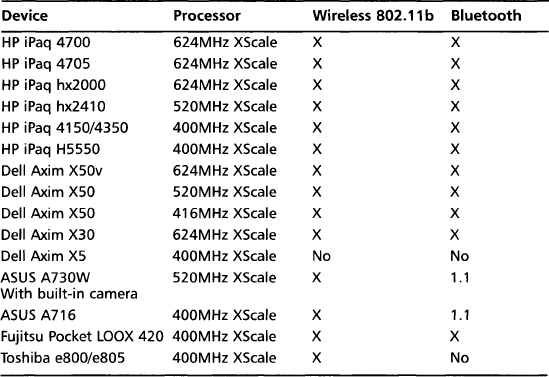
Many older Pocket PCs use a special 4C headset connector rather than the typical cell phone 2.5mm headset connector. Finding a headset for a 4C connector will pose a challenge. Your device might have come with a 4C to 2.5mm adapter, as the HP iPaq devices provide. Plantronics makes a headset with a 4C connector (M130i) for Pocket PCs. Learn more at www.plantronics.com/north_america/en_US/products/cat1150057/cat1150057/prod5070003?prodfind=true&mftr=HEWLETT+PACKARD.
Some additional things we found during testing were:
- Wired headsets worked best.
- Lowering the volume one setting from maximum helps reduce feedback and echo.
- Only a few units worked well without a headset (Toshiba and Siemens).
- Bluetooth did not work as well as wired headsets.
USB Phones for the Mobile Traveler
In Chapter 8, we covered many types of USB phone. We discuss them again here because they are specific to the mobile traveler. USB phones can make it easier to be mobile with Skype when you’re working with a laptop or if you borrow a computer to make a Skype call. There are currently two types of USB phone: the typical USB phone and the USB Flash phone. We expect a third type to show up, a Skype-enabled USB phone. Skype-enabled means that the display shows all the Skype information that is needed to make a Skype call, including contact names. Most USB phones require you to look at your computer screen when using them to dial your contacts.
Typical USB Phones
The typical USB phone simply plugs into an available USB port and provides a typical phone experience. If you want to be further away than a few feet, you will want to invest in a very long USB extension cable so that you are not restricted to a few feet from your computer—or look into a USB phone that is cordless.
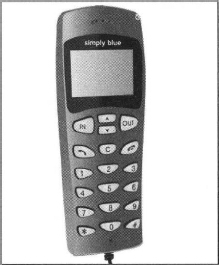
Photo as featured on www.simplyphone.lu
Typical USB phones are perfect for:
- Laptop users
- Businesses that want Skype to act like a regular phone
As we said in Chapter 8, USB Flash phones are perfect for the truly mobile Skyper. I wasn’t sure about this clever little device until I got my hands on one. This is a 100MB Flash drive that has a 2.5mm headset jack on the end and a volume button. Loaded on the Flash drive is a full working version of Skype! This device allows you to walk up to any computer with an open USB port and Internet connectivity and use all the features of Skype. Plug in the Flash phone and load Skype from the Flash device; you aren’t required to install anything on the host computer! Everything you need is loaded on the Flash drive—even your contacts.
In addition, this device has 90MB of storage space left over for files, pictures, and other data you want to carry with you. This device can use your standard 2.5mm cell phone headset, or it comes with a little earbud headset that will get you by. All of this fits into a little pouch the size of a deck of cards. I have friends who travel all over the world for extended periods of time; they use Internet cafes to check e-mail and send us pictures and even a joke or two during their travels. The USB Flash phone is perfect for them because it is portable, is easy to use, and works without loading anything on the borrowed computer.
As a consultant, I use clients’ systems as a part of my projects. If their policy allows the use of instant messaging, I can load up any IM tool that I need to communicate. Using a USB Flash phone, all I have to do is plug it into an available USB port. Since my Skype configuration is on the Flash drive, I don’t need to load software onto the client’s computer. Learn more at www.mplat.com/eng/productdetail.asp?post=27.
NOTE
This device needs a short USB extension because it is fat and might not fit into many recessed USB ports or alongside another USB device.

Photo as featured on www.mplat.com
The USB Flash phone is perfect for:
- Consultants
- Travelers using Internet cafes
- Stocking stuffers for your Skypers
- People who want to use Skype without loading it onto a borrowed computer
Understanding the Basics … Flash Phone
This device makes a perfect stocking stuffer for a Skyper.
Finding WiFi Hotspots
Being mobile with Skype often means finding a wireless (WiFi) hotspot where you can log into the Internet and surf while drinking your latte and, of course, using Skype. Here we provide many Web sites that will help you locate free or pay-per-use wireless access. In addition, we list several WiFi locator Web sites that cover many countries. If you find more good sites, let us know and we will post them on www.SkypeTips.com for everyone to share.
Skype Zones
Skype has partnered with a large wireless provider named Boingo. You can sign up for this service by the hour or by the month and have unlimited access to more than 20,000 wireless hotspots. For more information on this service, visit the Skype Zones site at www.skype.com/products/skypezones.
Pay-Per-Use WiFi Locators
- www.boingo.com/
- www.ipass.com/
- http://hotspot.t-mobile.com/
- www.wayport.com
- www.telecom.co.nz/content/0,3900,204163-1487,00.html
General WiFi Locators (Free or Paid)
- www.wifinder.com/
- www.wi-fihotspotlist.com/
- www.hotspot-locations.com/
- www.jiwire.com/
- www.surfandsip.com/location_all.htm
Free WiFi Locators
